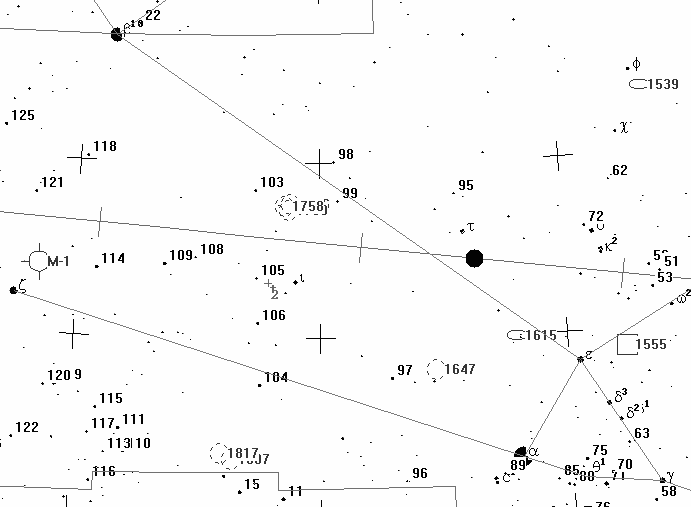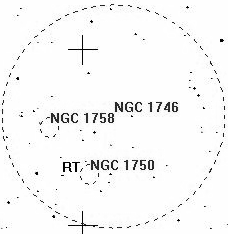On the Horns of Taurus
Jack Kramer
Taurus the bull is most famous for being the host constellation of the prominent Pleiades cluster, the bright orange-colored star Aldebaran (" ), and the Crab Nebula (M1). If you're interested in adding some deep sky objects to your observing log, you can pick up a few more just by hanging around the horns of the bull. Most are open clusters, but there are nebulae and galaxies as well. There are objects here that are good binocular targets, and some that will challenge even large scopes. The following charts are taken from the Guide v 8.0 computer program.

It seems that everyone who is working on a Messier list goes after M1 early in the process. After all, it is "number one" on the Messier list. Despite being magnitude 8.4, it's often difficult to find due to its large size, which reduces overall surface brightness. In most scopes, it appears as a roughly oval hazy patch just off the tip of the easternmost horn. Photographs show it with spikes around the circumference. I guess that's how it got the nickname "Crab". In pictures it looks a lot like you would expect a supernova remnant to look, and as you probably know, it is the remnant of the Supernova of 1054 that was recorded by the Chinese and perhaps also by native-Americans.
There's an interesting sidelight related to one amateur's search for M1. Geoff Gaherty of Toronto tells about an event at the 2001 Saskatchewan Star Party that involved Vance Petriew, a relative newcomer to observing.
"He was starhopping with his Starmaster 22 looking for M1, but started from the wrong star, Beta Tauri, instead of Zeta Tauri, an easy mistake to make - wrong horn of the bull. He found what he thought was M1, but it didn't look right, so he called his friend Rick Huziak over to take a look. Rick, who is one of Canada's top observers, knew instantly that this was not M1, and was 99% sure it was a comet. After checking star charts and plotting its position, they got on the cell phone to Harvard, and before dawn had confirmation that this was in fact an undiscovered comet."
And that's how Comet Petriew was discovered...while starhopping toward M1.
Now let's move on to some lesser-known objects within Taurus. Just above the head of the bull is the open cluster NGC 1647. This cluster, as well as some of the others, should be visible in 8x50 or larger binoculars. It's big and very loose with most component stars appearing to be of roughly identical magnitude. A yellow star lies at the edge of the field. My observing notes record that in a 70mm "copyscope" it appeared as a half-dozen brighter stars with a few fainter ones scattered about.
NGC 1807 and 1817 ("below" the eastern horn) are a pair of side-by-side clusters. Of the two, 1807 is the brighter and, although sparse, it has some concentration toward the center, making it easier to spot. NGC 1817 appears faint and somewhat elongated, and it's easier to spot with a low power, wide field ocular.

The three open star clusters NGC 1746, 1750 and 1758 are bunched together. The largest is NGC 1746, which spans over half a degree of sky. It's large, loose and stands out reasonably well in this sparse area of the sky, provided you have a very wide field of view. Within this large cluster are the smaller open clusters 1750 and 1758. I found NGC 1750 more difficult to distinguish within the larger cluster, although the stars tend to be brighter. NGC 1758 was easier to identify as a separate entity because it is more compressed, with stars of a variety of fainter magnitudes.
The galaxy NGC 1615 is a good challenge for those with a large enough scope - it's magnitude 15.0. The other galaxy in the area, NGC 1539, is even more difficult at magnitude 15.5. (No hope for me!)
Hind's Variable Nebula, NGC 1555, is 30 arcseconds in diameter and faint. It was discovered by J. R. Hind in 1852 using a 7-inch refractor. Then by 1868 it had disappeared, and was sighted again in 1890. In subsequent years, the luminosity of NGC 1555 fluctuated irregularly. Although it's only 40 arcseconds west of the variable star T Tauri, with which it's associated, the variability periods of the star and nebula do not coincide, contrary to what one might expect. I tried for it with my 6-inch APO to no avail and John Smith searched for it with his 15-inch, and he also came up empty-handed. The Night Sky Observer's Guide says it is a very difficult object, especially since it's so near the star T Tauri. I haven't been able to find any source that lists its current magnitude, but it's apparently near minimum brightness. Are you up for a challenge?
T Tauri gave its name to a type of star that is among the youngest visible and almost always found in diffuse nebulae. As these stars form, the in-falling gas gathers into an accretion disk around the star, releasing large amounts of energy. Most of the energy is absorbed by the surrounding gas and re-released as infrared (heat) and microwave radiation. This energy will often cause jets to erupt from the poles of the star. T Tauri varies erratically, and since it is enveloped by another compact mass of nebulosity, it is believed to still be growing by accretion. Some surmise that this type of star may also be in the early stages of forming a planetary system.
Finally, there's the face of the bull, the "V" shaped grouping known as the Hyades. It's not an NGC object, but is designated both as Collinder 50 (Cr50) and Melotte 25 (Mel25). At 150 LY, it's the second nearest open cluster to Earth. (Here's a quiz: Do you know which is the nearest star cluster to us?) Although Aldebaran appears to be a member of the Hyades, it actually is not. Both orange and white colored stars make up this cluster, which means it's an interesting group to observe with binoculars or a spotting scope. In a larger telescope, the Hyades loses its appearance as a cluster; however, a number of its component stars are nice doubles that take higher magnification.





